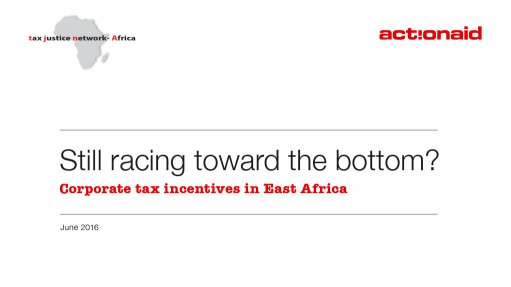
In 2012, ActionAid and Tax Justice Network Africa published a report containing estimates of how much revenue East African countries were losing by providing tax incentives.1 Tax incentives often beneft foreign corporations, as they involve governments reducing or eliminating taxes such as corporate income tax, customs duties or VAT payments, and are ostensibly provided to encourage investment, including foreign investment. The 2012 report estimated that revenue losses from providing such incentives were massive – up to US$2.8 billion a year for just four East African countries: Tanzania, Kenya, Rwanda and Uganda. Especially large estimated annual losses were documented in Tanzania (US$1.2 billion) and Kenya (US$1.1 billion) but signifcant revenues were also being squandered in Uganda (US$272 million) and Rwanda (US$234 million). These lost revenues could be much better used to fund critical health, education and other public services. The 2012 report received – and continues to receive – widespread attention from the media and governments.
Our 2012 report also documented that many governments in East Africa were pledging to reduce or eliminate tax incentives, which ActionAid and its partners are also advocating them to do. Four years on, this current report asks: What progress has been made since 2012 in reducing tax incentives in East Africa, and have governments kept their promises?
Our fndings are mixed. Governments have taken some positive steps to reduce tax incentives, especially those related to VAT, which is increasing tax collections and providing vital extra revenues that could be spent on providing critical services. However, they are still failing to eliminate all unnecessary tax incentives, including those such as corporate income tax incentives given to corporations. Although precise fgures are impossible to provide due to a lack of transparency when it comes to numbers and vital statistics on incentives, evidence gathered suggests that collectively, fgures from the four2 East African countries focused on in this report could still be losing around US$1.5 billion and possibly up to US$2 billion a year:
- The Tanzanian government has remained committed to reducing tax incentives and deserves praise for having taken some concrete steps to do so, especially in introducing a new law in 2015 to reduce VAT exemptions. Yet more needs to be done as the country continues to ofer numerous incentives to foreign investors, especially within its Export Processing Zones and Special Economic Zones, and to oil and gas investors. Revenue losses from tax incentives given in 2014/15 were likely to be around US$790 million; although this fgure predates a new VAT law that is claimed will result in extra revenues of US$500 million.
- In Kenya, government ofcials often say they are committed to reducing tax incentives, and some limited steps have been taken. However, actual policy has mainly been to maintain and even increase tax incentives, notably though introducing new Special Economic Zones. The amount of revenue lost is unclear since Kenya’s tax incentive regime remains completely un-transparent, but it is likely to be near the 100 billion Kenyan shillings (US$1.1 billion) a year level that our 2012 report mentions.
- The Ugandan government has also continued its commitment to reduce tax incentives, and has taken signifcant steps to reduce VAT and some other exemptions, expected to increase tax collections by 0.7% of GDP. However, many incentives for corporations remain, notably for oil companies. It remains unclear how much Uganda is losing to tax incentives since government fgures do not appear in full, but the amount is likely to remain large.
- In Rwanda, the government has taken steps to reduce some tax incentives, but it has also gone backwards by bringing in a new Investment Code that ofers far-reaching tax incentives to foreign investors. Estimates suggest that Rwanda is losing between 87-123 billion Rwandan francs (US$115-176 million) a year.
- For Burundi, determining revenue losses due to tax incentives was particularly challenging owing to an almost complete lack of data. Burundi’s President Pierre Nkurunziza recently indicated that at least 81 billion Burundian francs (US$52 million3 ) have been lost to companies or ofcials given tax exemptions to import goods to build infrastructure, and who instead sold on the materials.4 As a small and poor country, Burundi needs to strengthen its revenue collection to collect all the resources available. Tax incentives to attract foreign direct investment may prove to be especially harmful to Burundi, as there is very little tax base to begin with. These exemptions drastically reduce revenues for the state to be able to provide for quality public goods and services.
In comparison to our 2012 report, the East African Community (EAC) countries have shown that there is regional political will towards ending harmful tax incentives to multinationals. However, what seems to have not been understood is that it takes more than just political will to achieve this. Stronger policies need to be further implemented at both country and regional levels to make sure that they efectively seal loopholes, and that the region is able to get its rightful share of lost tax revenue. As this report fnds, although the region has lost less since 2012, the fgure of US$2 billion a year is likely to go up again if more is not done – especially at the policy implementation level – on ending harmful tax incentives, harmful tax competition and double taxation avoidance.
Report by ActionAid